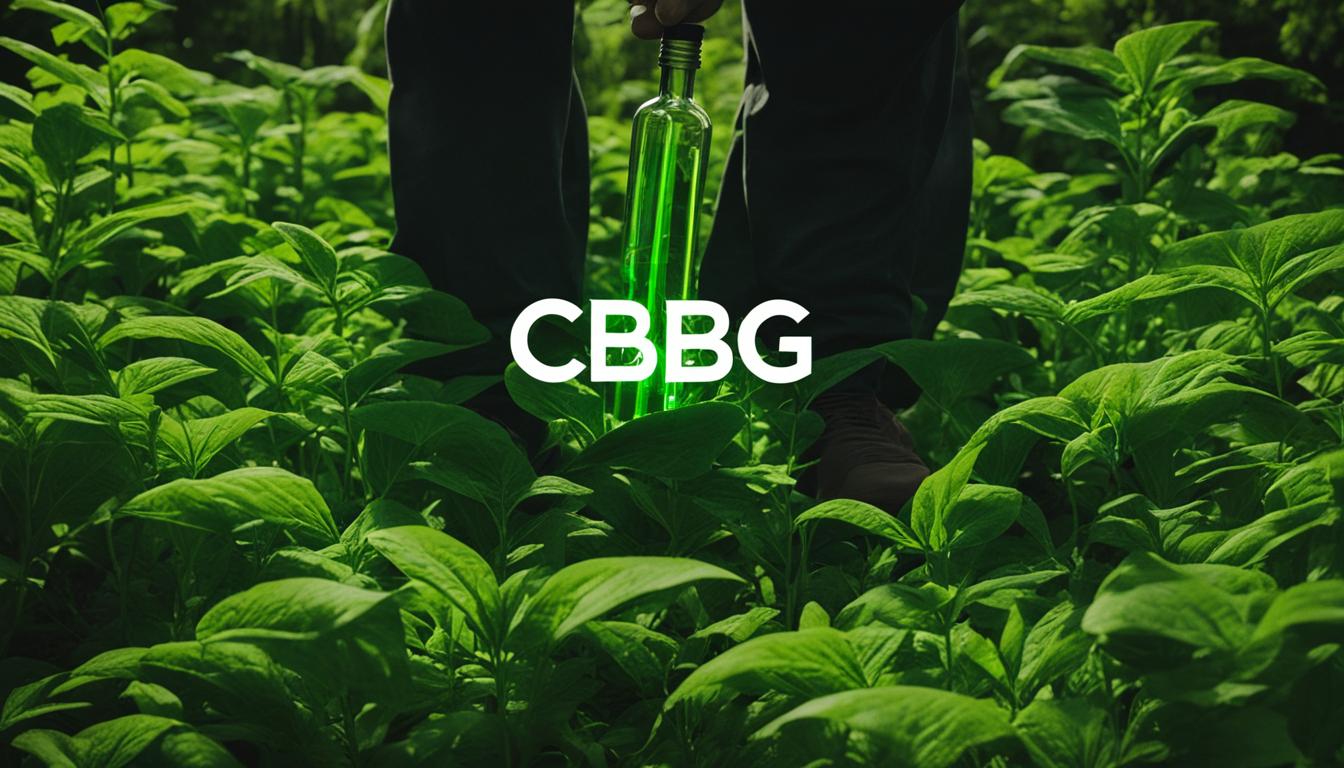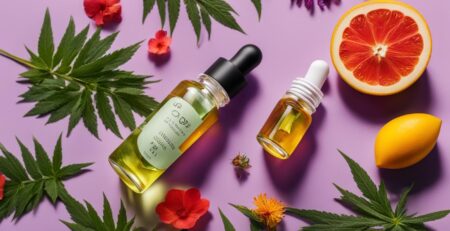Unlocking CBG Benefits for Wellness & Health
The journey towards a balanced and enriched life is continually evolving, and among the natural wellness frontiers gaining traction is CBG, short for Cannabigerol. As a promising cannabinoid, CBG benefits are emerging in the spheres of wellness and health, heralding a new chapter of therapeutic possibilities. Distinct from its more acclaimed counterparts THC and CBD, CBG stands out due to its non-psychoactive nature, offering potential health benefits without the intoxicating effects commonly linked to cannabis.
With the spotlight on natural wellness solutions, CBG is being acknowledged for its potential in combatting various health concerns. Initial research points towards its anti-inflammatory, neuroprotective, and anxiolytic properties, positioning CBG as an attractive aid for managing conditions like inflammation, neurological disorders, anxiety, and depression. Navigating the correct dosage tailored to individual needs is fundamental in harnessing the full scope of CBG's effectiveness.
Key Takeaways
- Cannabigerol (CBG) showcases promising therapeutic benefits for natural health and wellness.
- CBG is a non-intoxicating cannabinoid, making it an ideal solution for those seeking benefits without a psychoactive high.
- Research suggests CBG may offer anti-inflammatory, neuroprotective, and mood-stabilizing advantages.
- Finding the right CBG dosage is essential for maximizing its wellness potential.
- CBG is increasingly becoming a key player in natural health discussions and personalized wellness regimens.
Exploring the Rise of Cannabigerol in Wellness
Within the expansive landscape of cannabinoids, a relatively unfamiliar compound is stepping into the limelight: Cannabigerol, or CBG. Unlike the commonly discussed THC and CBD, CBG, often regarded as the “mother cannabinoid,” has begun to spur interest for its multitude of health and wellness applications. As researchers and wellness enthusiasts continue to unravel the cannabigerol benefits, the narrative of CBG oil benefits is enriching the conversation on cannabinoids in wellness.
CBG's ascent in the wellness domain marks a significant turn in how we perceive the therapeutic potential of cannabinoid compounds. Its non-psychoactive nature renders it an appealing option for those seeking holistic wellness solutions. Let us delve deeper into what CBG is and trace its burgeoning recognition within health circles.
What Is CBG and Its Place Among Cannabinoids
CBG, celebrated as the progenitor from which all other cannabinoids synthesize, manifests in its most abundant form during the cannabis plant's early growth stages. In the wake of maturation, CBG transforms into various cannabinoids, including THC and CBD. However, the health community has started to recognize cbg oil benefits, distinct from its cannabinoid relatives, for its potential to support various bodily functions without inducing intoxication.
The Evolution of CBG’s Recognition in Health Circles
The acknowledgment of CBG within the wellness arena has taken strides with ongoing studies suggesting a broad spectrum of potential therapeutic effects. From acting as a neuroprotector to offering anti-inflammatory promises, the exploration of cannabinoids in wellness has indeed broadened to encompass the diverse capabilities of CBG. This evolution is not only reshaping our understanding of cannabinoids but is also transforming CBG into a wellness commodity sought after for its distinct health-affirming properties.
- Cannabigerol's influence on neuroprotective and anti-inflammatory pathways
- Anxiolytic effects and its role in psychological health management
- Capability as a potential therapeutic agent across a spectrum of conditions
As the world of wellness continues to embrace natural health modalities, CBG stands at the forefront, promising an enriching addition to the cannabinoid family. Its recognition as both a standalone and a synergistic component marks the dawn of a new era in cannabinoid therapeutics and holistic health.
Cannabigerol 101: Understanding the Basics of CBG
Embarking on a path of natural health often leads to the discovery of compounds such as Cannabigerol (CBG), a less spotlighted but increasingly interesting cannabinoid. Gaining momentum in wellness communities, the basics of CBG are crucial for those interested in alternative health approaches. This cannabinoid, found in modest concentrations in most cannabis strains, is commonly referred to as the “parent” molecule.
For many, understanding CBG is the first step towards appreciating its potential as a non-psychoactive cannabinoid within the vast arena of health and wellness. Unlike its counterparts THC and CBD, CBG does not impart intoxicating effects, making it an enticing option for users seeking health benefits without a psychoactive experience.
At the genesis stage of the cannabis plant, CBG is abundantly produced, giving rise to other cannabinoids like THC, CBD, and CBC through natural processes as the plant matures. This transformation underscores the pivotal role of CBG in cannabis horticulture and its emerging significance in research circles for its possible therapeutic advantages.
- Anti-inflammatory effects may offer benefits in treating conditions such as arthritis or inflammatory bowel disease.
- Neuroprotective properties suggest a potential for aiding neurodegenerative diseases through nerve cell protection.
- Potential for mood stabilization, considering its interaction with key receptors, may provide a natural alternative for managing mood disorders.
The intrigue around CBG and its health benefits continues to grow as studies shed light on its interactions with the body's endocannabinoid system. Join us as we explore the therapeutic potential of this unique cannabinoid and consider its place in a wholesome lifestyle.
Distinction Between CBG and Other Cannabinoids
In the ever-expanding world of cannabinoids, discerning the unique attributes of each compound is pivotal. The distinction between CBG (Cannabigerol) and its more notable counterparts, THC (Tetrahydrocannabinol) and CBD (Cannabidiol), is essential for understanding their individual contributions to health and wellness. Here we explore the nuances that differentiate CBG from other cannabinoids and highlight the reasons why this particular compound is gaining interest in the medical community.
Comparing CBG to THC and CBD
The comparison of CBG vs THC and CBG vs CBD reveals fundamental cannabinoid differences that impact their effects and uses. THC, known for its psychoactive properties, is the primary compound responsible for the ‘high' associated with cannabis. In contrast, both CBG and CBD are non-psychoactive, making them appealing for those seeking therapeutic benefits without the altered state of consciousness. While CBD has been the focus of much research and consumer interest, CBG is distinguishing itself due to its ability to interact with the body's endocannabinoid system (ECS) differently than CBD does.
For instance, the efficacy of CBG vs CBD in areas of muscle tension relief and inducing mental calmness varies. Furthermore, while CBD products offer slight advantages in mental relaxation, CBG shines in promoting calmness and relaxation after physical exertion. Moreover, CBG and CBD can act synergistically, suggesting that combining the two may lead to enhanced effects for users.
Unique Properties of Cannabigerol (CBG)
As research into CBG unfolds, its unique properties are beginning to come to light. Unlike THC, CBG's non-intoxicating nature positions it as a compelling candidate for medical applications without the psychoactive risks. Researchers are investigating CBG's potential roles as an antimicrobial, anticancer, and appetite-stimulating agent, showcasing a promising future for this cannabinoid in diverse therapeutic settings.
Understanding how CBG works within the endocannabinoid system is the key to unlocking its potential benefits. Its ability to interact with both CB1 and CB2 receptors suggests that it has a comprehensive influence on maintaining the body's internal balance. The current focus on CBG is reflective of a broader trend toward exploring less known cannabinoids for their health-promoting potential, in hopes of finding viable alternatives to traditional health approaches.
CBG Benefits: From Reducing Inflammation to Neuroprotection
As discoveries in cannabinoid research progress, the health advantages of Cannabigerol (CBG) have captured the attention of the medical community and wellness enthusiasts alike. Touted as ‘the mother of all cannabinoids,' CBG is shedding its shadow of obscurity and presenting promising therapeutic properties. From its capacity to mitigate discomfort caused by inflammatory disorders to bolstering cognitive health, the potential cbg health benefits are extensive and diverse. Intriguing evidence also showcases Cannabigerol as a beacon of hope for enhancing emotional well-being.
The Anti-Inflammatory Effects of CBG
Cannabigerol might be the relief seekers' solace in the battle against inflammation. Research has illuminated CBG's efficacy in soothing inflamed bodily systems – offering a ray of hope for those suffering from inflammatory conditions such as arthritis or inflammatory bowel disease. These findings underscore cbg for inflammation as a viable consideration in developing future therapeutic strategies.
Neuroprotective Properties and Cognitive Health
Neurodegeneration is an ominous cloud over the horizon of public health, beckoning new interventions. Here, neuroprotective cbg emerges as a potential ally. Encouraging studies hint that CBG might guard the nervous system's structural integrity, protecting nerve cells and potentially offering a novel approach to managing neurodegenerative disorders.
Cannabigerol’s Role in Anxiety and Depression Management
In the realm of mental health, the effects of CBG are being keenly investigated. Early investigations into cbg for anxiety and depression convey Cannabigerol's potential in modulating key neurotransmitters, possibly offering a more natural solution for those navigating these challenging conditions.
CBG for Pain Relief: Investigating the Analgesic Potential
The therapeutic landscape for pain management is expanding as Cannabigerol (CBG), a non-psychotropic cannabinoid, demonstrates promising analgesic effects of CBG. Rooted in its unique interaction with bodily systems, CBG for pain relief is gaining attention from healthcare professionals and patients. This burgeoning curiosity pivots on the compound's anti-inflammatory and neuroprotective properties, which conjure a natural approach towards alleviating chronic pain without the side effects associated with standard pain medications.
Delving into CBG's analgesic landscape, initial studies and anecdotal evidence suggest that cannabigerol could indeed play a pivotal role in pain mitigation. Populating the conversation with new insights, these early indicators are setting the stage for in-depth clinical research, aimed at validating CBG's pain-relieving prowess.
Understanding CBG's mode of action furthers the conversation about its potential as a pain-relief adjunct or alternative. Engagement with the body's endocannabinoid system (ECS) hints at how CBG could potentially quell pain while sidestepping the psychoactivity that THC carries—a distinct advantage for seeking relief without altering consciousness.
| Benefits | Property of CBG | Potential Impact on Pain |
|---|---|---|
| Anti-inflammatory Action | Interacts with endocannabinoid receptors | May reduce pain from inflammatory conditions |
| Neuroprotective Effects | Shields nerve cells | Possible benefits in neuropathic pain |
| Non-psychoactive | Does not induce “high” | Provides pain relief without cognitive impairment |
| Analgesic Potential | May possess higher pain-relieving properties than THC | Could be effective for managing chronic pain |
The table above encapsulates the intersection of CBG's pharmacological traits with its analgesic narrative. These characteristics are just the tipping point, stirring the medical community to heighten research endeavors. Utilization of CBG for pain relief not only propels forward the conversation on cannabinoids as viable therapeutics but also exemplifies the quest for plant-based remedies tailored to contemporary health needs.
In conclusion, while CBG's analgesic potential remains under exploration, the compelling data resonates with a clarion call for comprehensive studies. Such inquiry could illuminate pathways to more effective, more natural pain management options, echoing through the realms of medicinal science and patient care alike.
Leveraging CBG Benefits for Better Sleep and Relaxation
As modern lifestyles grow increasingly hectic, a good night's sleep has become a precious commodity. Recognizing the importance of rest and unwinding, there's a growing emphasis on all-natural solutions like Cannabigerol (CBG) for improving sleep and aiding relaxation. A relatively new entrant in the wellness lexicon, CBG has shown potential in enhancing sleep quality and serving as a conduit for tranquility in our daily lives.

How CBG Can Improve Sleep Quality
Amidst the myriad natural options emerging for improving sleep with CBG, CBG stands out due to its interaction with the body's inherent endocannabinoid system. This system plays a crucial role in regulating sleep patterns, and CBG's influence could positively impact sleep quality. Explorations into cbg for sleep suggest that its application may aid individuals in achieving deeper and more restorative sleep cycles, which are key components of effective rest.
Cannabigerol’s Impact on Stress and Relaxation
CBG for relaxation shows promise, with reports indicating that it serves as a gentle aide to soothe the day's stresses away. Suitable for incorporating into evening routines, CBG may contribute to a sense of overall calmness, providing a conducive environment for winding down. Pioneering consumers have also experienced improved relaxation when using CBG in combination with CBD, capitalizing on the supposed synergistic effects that amplify the qualities of both compounds.
| CBG Benefits | How It Helps | Consumer Experiences |
|---|---|---|
| Sleep Support | Interacts with sleep-related receptors | Reported deeper and more consistent sleep |
| Relaxation Aid | Promotes calmness in the nervous system | Felt more relaxed and tranquil during the evening |
| Synergy with CBD | Combines properties of both for enhanced effect | Noticed improved serenity and well-being |
In this context, it's evident that the use of CBG as a naturally-derived aid for sleep and relaxation is on the rise. As testimonials and preliminary research converge, the benefits of CBG offer a glimpse into the cannabinoid's capacity to harmonize the essential elements of sleep and stress relief, highlighting its potential role in personal wellness regimens.
The Emerging Role of CBG in Skin Care Regimens
With the wellness industry continuing to explore natural ingredients, CBG for skincare is increasingly becoming a focal point amongst consumers and experts alike. Capitalizing on the potential anti-inflammatory and antimicrobial properties of CBG, skincare formulators are infusing this cannabinoid into their products, aiming to deliver new solutions that cater to the unique needs of various skin types. As we navigate through the array of cannabinoid skincare benefits, CBG stands out as a versatile and promising addition that aligns with the current shift towards plant-based skincare regimens.
The infusion of CBG into skincare products is more than just a trend; it's a researched-based approach that combines science and nature to address common skin concerns. This powerful cannabinoid has been shown to help with reducing the appearance of redness, soothing irritated skin, and managing skin health overall. Below, we offer a deeper insight into the characteristics of CBG that are driving its adoption in skincare innovations.
- Potential to reduce the appearance of inflammation in conditions like acne, eczema, and psoriasis
- May help in the management of skin's sebum production, contributing to a balanced complexion
- Antimicrobial properties suggest it could aid in protecting the skin from harmful bacteria
The landscape of skincare is evolving, with CBG skincare products creating a bridge between therapeutic care and daily beauty routines. The positive effects associated with CBG's properties not only promise healthier-looking skin but may also offer a layer of delight for those indulging in self-care practices that foster overall well-being.
To fully comprehend the potential of CBG within the skincare arena, further research and customer anecdotes suggest looking into the experiences of those who have incorporated cannabinoid-infused products into their regimens. Anecdotal evidence hints at users observing improvements in their skin's condition, which could be indicative of the compound's efficacy when used consistently as part of a skincare routine.
As CBG's presence in the skincare domain gains momentum, the excitement surrounding cannabinoid-infused products is palpable. Acknowledging cannabinoid skincare benefits, forward-thinking brands are investing in research and development to offer innovative solutions that are not only effective but are also rooted in the wellness philosophy that guides the modern consumer.
CBG and Appetite Stimulation: Understanding the Connection
The exploration of CBG's impact on wellness extends to its intriguing interaction with appetite control. Notably, like THC, CBG has demonstrated promise in stimulating appetite, offering respite for individuals struggling with inadequate nutrient intake or diminished appetite due to various health conditions. This connection underscores the significance of understanding the mechanisms behind CBG and appetite stimulation, shedding light on the potential benefits that CBG may harbor in regulating and promoting a healthy appetite.
Recognizing the intricacies of cannabinoid receptors in maintaining bodily equilibrium, CBG's role in this balance encompasses aiding homeostasis and potentially encouraging nutrient absorption. As clinical investigations unfold, the compelling aspect of appetite control CBG merits further inquiry, poised to redefine dietary management and wellness strategies.
Use of CBG for Appetite Control in Clinical Settings
In clinical scenarios, CBG emerges as an ally in appetite regulation. Its ability to modulate the endocannabinoid system illustrates CBG's capacity to support metabolic processes and maintain a balanced approach to appetite. Such insights are paving the way for CBG to be utilized in settings that necessitate appetite stimulation as part of a broader wellness plan. Notably, this attribute of CBG could play a pivotal role in comprehensive care for patients experiencing appetite loss, aligning medical treatment with cutting-edge cannabinoid research.
Optimizing Your Health: Effective CBG Dosage and Administration
Embarking on the CBG journey requires understanding the intricacies of effective cbg dosage and the cbg administration methods that can have a significant impact on your wellness strategy. Each individual's experience with CBG is unique, necessitating a personalized approach to finding the right dosage and administration method that aligns with one's specific health objectives and bodily responses.

Factors Influencing CBG Dosage for Individuals
The right amount of CBG for optimizing health can vary greatly from person to person. A myriad of factors play a role in determining that perfect measure which coalesces efficacy with safety. Body weight, metabolism, specific health conditions, and your tolerance to cannabinoids inform the starting point and subsequent adjustments in dosing. Beginners or those switching to a new administration method should always begin with a conservative amount, observing the effects and adjusting with caution.
Different Methods of CBG Administration
The executive choice of how to take CBG can make a considerable difference in its effectiveness. From the immediacy of inhaled vapors to the extended release from oral ingestion, each cbg administration method comes with its distinct onset time and duration of effects. Topical applications appeal for localized issues while sublingual drops offer a compromise between speed and convenience. One's method of administration should reflect personal preferences and targeted health outcomes.
| Administration Method | Bioavailability | Onset of Effects | Duration of Effects |
|---|---|---|---|
| Oral (Edibles, Capsules) | Lower due to digestive metabolism | 1-2 hours | 4-6 hours |
| Sublingual (Tinctures, Oils) | Medium, faster absorption via oral mucosa | 15-30 minutes | 2-4 hours |
| Inhalation (Vaping, Smoking) | Higher, direct entry into bloodstream | Immediate to few minutes | 1-3 hours |
| Topical (Creams, Lotions) | Localized, does not enter bloodstream | Varies, local application | Varies, typically 1-4 hours |
As we appreciate the versatility of CBG, it's evident that the pathway to optimum health can be paved with an informed approach to effective cbg dosage and cbg administration methods. Personalization and careful consideration, exercised under the guidance of healthcare professionals, stand central to a health-forward CBG experience.
Incorporating CBG into Daily Life for Wellness
As we pivot towards holistic health practices, integrating CBG daily wellness strategies has become increasingly popular for those seeking a more natural approach to maintaining well-being. To fully realize the benefits CBG offers, it's critical to find high-quality CBG products and understand how to meld them seamlessly into your lifestyle alongside other healthful practices.
Finding Quality CBG Products
Selecting quality CBG products is crucial to ensure safety and efficacy in your wellness routine. Begin by examining the source of the hemp, the extraction methods used, and the purity of the final product. Look for providers that offer full transparency, including readily available and comprehensible Certificates of Analysis (CoA). These documents provide verification from third-party labs that the product meets stringent quality and safety standards.
Integrating CBG with Other Healthy Practices
For those invested in their health, integrating CBG into daily routines should complement other established wellness practices. Whether it be a balanced diet, regular physical activity, or mindfulness exercises, CBG can serve as a supportive element in this holistic equation. Consider starting with a modest dose, evaluating its effects, and then adjusting as necessary in harmony with your body's cues and existing health habits.
CBG can play a synergistic role when combined with a varied lifestyle, possibly enhancing overall homeostasis and well-being. The potential for CBG to support a calm and focused state makes it a noteworthy adjunct to a comprehensive approach to health, encompassing both mental and physical domains.
- Begin with high-quality, lab-tested CBG products to ensure safety and potency.
- Incorporate CBG as part of a broader wellness strategy alongside healthy eating and exercise.
- Utilize full spectrum CBG products to benefit from the entourage effect, which may enhance the therapeutic potential.
- Mindfully observe the body's response to CBG and make dosage adjustments to suit personal wellness goals.
Ultimately, the incorporation of CBG into daily life is an individual journey, one that should prioritize both quality of product and harmony with one's personal health objectives. By doing so, CBG can become a valuable ally in promoting daily wellness and an improved quality of life.
Legal Status and Safety of Using CBG
When it comes to navigating the realm of cannabinoids, understanding the legality of CBG is of utmost importance for consumers, healthcare professionals, and businesses alike. The cannabinoid legal status in the United States has become less opaque with the advent of the 2018 Farm Bill, which has set clear regulations for hemp-derived compounds, including CBG.
The federal guideline stipulating that hemp and its derivatives are legal provided they contain less than 0.3% THC, has formed the backbone for the CBG safety protocol across the nation. Consequently, CBG, renowned for its non-psychoactive properties, passes the legislative checkmark as a legally consumable product in all 50 states, resting comfortably within the ambit of the defined law.
Safety, a companion to legality, is another priority issue addressed through rigorous assessments. CBG products undergo a stringent analytical process, typified by laboratory testing and transparent documentation via Certificates of Analysis (CoA). These certificates vouch for the product's THC content, purity, and quality—providing a shield of confidence for consumers keen on CBG use.
- Legality: CBG is federally legal in the USA with
- Safety: Safety measures include lab testing and CoAs.
- Availability: Legally available for purchase and use in all 50 states.
As the awareness of CBG's safety and legal status continues to expand, a burgeoning market has opened, solidifying CBG's place in the legal and safe consumption of wellness products.
Demystifying Full Spectrum CBD and CBG’s Place Within It
Unlocking the potential of hemp extract goes beyond CBD isolation, extending towards a multifaceted spectrum that includes full spectrum CBD, renowned for its holistic approach to wellness. Within this spectrum, a noteworthy player emerges: CBG, also known as Cannabigerol, whose role is pivotal in amplifying the wellness dynamism of hemp through a phenomenon known as the entourage effect.
Exploring the Synergy Between CBG and Other Hemp Compounds
The realm of full spectrum CBD is abuzz with the talk of cbg synergy, which refers to the collaborative interaction between various hemp compounds. CBG, amidst its cannabinoid peers, is believed to magnify their collective effects, resulting in an enhanced experience often greater than the sum of its parts. This entourage effect underscores the therapeutic edge that full spectrum CBD harnesses over CBD in isolation.
While CBD plays a central role, CBG adds a complementary layer, enriching the therapeutic tapestry with its unique properties. From elevating mood and pain relief to potentially reducing inflammation and encouraging neuroprotection, CBG has carved out a niche for itself within the complex matrix of hemp phytochemicals.
Consumer experiences and ongoing studies suggest that full spectrum CBD, with its concert of cannabinoids including CBG, offers a more complete approach to cannabinoid-based wellness. Assimilating CBG with a wide array of hemp-derived compounds may offer profound benefits, positioning full spectrum products as the embodiment of cannabinoid synergy for health and well-being.
| Component | Role in Full Spectrum CBD | Contribution to Entourage Effect |
|---|---|---|
| CBG (Cannabigerol) | Non-psychoactive cannabinoid | Enhances overall therapeutic outcomes |
| CBD (Cannabidiol) | Major non-intoxicating cannabinoid | Contributes to wellness and balance |
| Terpenes | Aromatic compounds | Augment flavor and therapeutic properties |
| Other minor cannabinoids | Various supportive roles | Provide comprehensive health benefits |
Ultimately, the full spectrum narrative is intricate and nuanced, with each cannabinoid, including CBG playing a salient role. As the wellness community continues to embrace the expansive properties of full spectrum CBD, CBG is set to be a cornerstone of the burgeoning hemp revolution, manifesting as a linchpin in the entourage effect that drives holistic health forward.
Personalizing Your CBG Experience
Embarking on a journey with Cannabigerol (CBG) is a venture of personal wellness, one that prizes the individuality of each user. To personalize your CBG experience, a key step is to determine a personalized dosage that best aligns with your unique physiological makeup and wellness goals. This customization is not a mere suggestion but a pivotal aspect of maximizing the purported benefits CBG has to offer in terms of health and vitality.
Adjusting Dosage for Unique Individual Needs
When it comes to CBG intake, a ‘one-size-fits-all' approach falls short of addressing the intricacies of individual body dynamics. As each person's body reacts distinctly to cannabinoids, finding the appropriate dosage that corresponds to your body weight, metabolism, and specific condition becomes imperative. Commence with a modest amount of CBG, then slowly enhance your dosage while vigilantly observing the body's response. This vigilant practice paves the path to an optimized personalized dosage and a personalized CBG journey.
Assessing Personal Tolerance and Effects
Monitoring CBG tolerance closely ties into the personalization process. By evaluating the body's responses and potential side effects at varying doses, users forge an understanding of their tolerance levels. This critical evaluation is optimally performed under the tutelage of healthcare professionals, ensuring both the safety and efficiency of your personalized regimen. Achieving the most suitable and rewarding dosage for CBG is akin to fine-tuning a musical instrument—it involves patience, attention to detail, and an understanding that subtle adjustments can lead to harmony and optimal performance.
FAQ
What Is CBG and Its Place Among Cannabinoids?
CBG, or cannabigerol, is a non-psychoactive cannabinoid found in the cannabis plant. It's considered the “parent” cannabinoid because other cannabinoids like THC and CBD are derived from its acidic form. Unlike THC, it does not produce a “high” and is recognized for its potential therapeutic benefits.
How Is CBG Different from THC and CBD?
Unlike THC, CBG is non-psychoactive, meaning it doesn't produce the intoxicating effects associated with marijuana. While both CBG and CBD are non-psychoactive, each interacts with the endocannabinoid system in unique ways and has distinct potential health benefits. CBG has also been studied for uses that differ from those of CBD, including as an antimicrobial and appetite stimulant.
What Are the Benefits of CBG for Inflammation and Cognitive Health?
CBG has demonstrated promising anti-inflammatory properties, which may help manage conditions like inflammatory bowel disease and arthritis. Additionally, it shows potential in neuroprotection, which might aid cognitive health and assist those with neurodegenerative diseases.
Can CBG Help with Pain Relief?
Yes, early evidence suggests that CBG has analgesic properties, which could make it useful for managing chronic pain without the psychoactive effects associated with THC.
How Can CBG Improve Sleep Quality and Aid Relaxation?
CBG may interact with the body's endocannabinoid system to help regulate sleep and stress response. Its potential sedative effects could aid in improving sleep quality and promoting relaxation.
What Role Does CBG Play in Skincare?
The anti-inflammatory and antimicrobial properties of CBG may prove beneficial in skincare, helping to reduce inflammation and fight bacteria which can lead to skin conditions.
How Does CBG Influence Appetite?
CBG has been shown to stimulate appetite, which could be beneficial for individuals needing to increase their nutrient intake or those who experience appetite loss due to medical conditions.
What Are the Best Practices for CBG Dosage and Administration?
The optimal CBG dosage varies based on individual factors such as body weight and metabolism. It's recommended to start with a low dose and gradually adjust. Administration methods include oral, sublingual, inhaled, or topical applications, affecting the bioavailability of CBG.
How Can I Incorporate CBG into My Daily Wellness Routine?
Look for high-quality CBG products with a certificate of analysis, and consider integrating these products alongside a balanced diet and regular physical activity. Full spectrum extracts may provide additional benefits due to the entourage effect.
Is CBG Legal and Safe to Use?
CBG derived from hemp plants containing less than 0.3% THC is legal in the United States under the Farm Bill. Always ensure products are lab tested and come with a certificate of analysis for safety.
What Is the Relationship Between Full Spectrum CBD and CBG?
Full spectrum CBD includes a variety of cannabis plant compounds, including CBG. The “entourage effect” theory suggests these compounds work better together than in isolation, potentially enhancing the therapeutic effects of the product.
How Do I Personalize My CBG Experience?
Start with a lower dose of CBG and tailor it based on your body's response, ideally under the supervision of a healthcare professional. This approach helps you find the most effective dosage for your specific needs and goals.











Leave a Reply